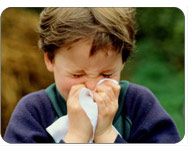Colds and Flu
Young children are among the most susceptible age group to repeatedly be infected with common cold viruses. But how do you know when it's just a cold that will soon pass or the more troublesome flu?
The Common Cold
Because viruses cause the common cold, once you get a sick, you develop immunity to that particular strain. However, since there are more than 200 different types of cold viruses, you will never be immune to every cold out there.

To get sick, the virus must invade the nasal membranes, which can easily be done through touching surfaces that have cold germs on them and then touching your own nose or even just rubbing your eyes. People are more likely to get infected with a cold virus during the winter months, although a cold can occur at any time. As many parents have suspected, children in daycare tend to experience more colds than children who stay at home. Teaching your preschooler to wash her hands frequently can help to limit the amount of exposure she receives to germs.
Although it can take several weeks for all the symptoms of a cold to completely go away, in general a cold lasts seven to ten days. The most common symptoms of a cold include:
- Mild fever
- White, yellow or greenish nasal mucus
- Sore throat
- Swollen neck lymph glands
- Cough (which may be worse at night)
- A general "sick" look
A person will often develop a sore throat or cough before a fever occurs. The fever will develop after, if at all, as the body begins to fight off the infection.
Sometimes, young children can contract mononucleosis. Mono is an illness that very much resembles a cold, only it causes terrible fatigue. If you think your child may have mono, investigate treatment for mononucleosis.
The Flu
Although the symptoms can be similar to the common cold, the flu is much more contagious and symptoms can persist for much longer. The flu is caused by a virus, which means that once your child gets it, she will be immune from future infections. However, influenza virus strains tend to change every year, so her immunity is only good for a little while. Getting a flu vaccine every year can help to reduce her chances of getting infected.
Catching the flu is relatively easy - your child simply needs to be in close proximity to another person that has the virus. Breathing in infected air droplets is sufficient exposure to become infected. Flu infection tends to be at its peak between November and April and is usually marked by a sudden fever, often higher than 101°F. Other common symptoms of the flu include:
- Muscle aches
- Chills
- Fatigue
- Loss of appetite
- Clear, runny nose
- Vomiting or diarrhea
Your preschooler should start to feel better within five days of developing flu symptoms. However, a cough, fatigue, and muscle aches can for continue for two or more weeks.
What You Can Do
Here are some things that you can do to help ease your preschoolers discomfort when he's sick:
- Use a humidifier in his room to add moisture to the air and help ease his congestion
- Prop his head up when he sleeps with a few extra pillows
- Provide lots of fluids. While it's normal to have a decrease in appetite, not getting enough fluids can lead to dehydration especially if your child is vomiting, has a fever or diarrhea.
- To help ease a sore throat and temporarily clear up nasal passages, serve lots of warm liquids. Avoid giving children under four-years-old throat lozenges, as they can be a choking hazard.
- Use medications sparingly. Try to reserve them for when they are most needed, like at night time to help your child sleep. Medications will not make child your better, they will only ease some of the discomfort she is experiencing.
If your preschooler's symptoms do not improve within a few days, if they get worse or new symptoms develop, like severe headaches, stomach pains, or respiratory troubles, contact his pediatrician.
